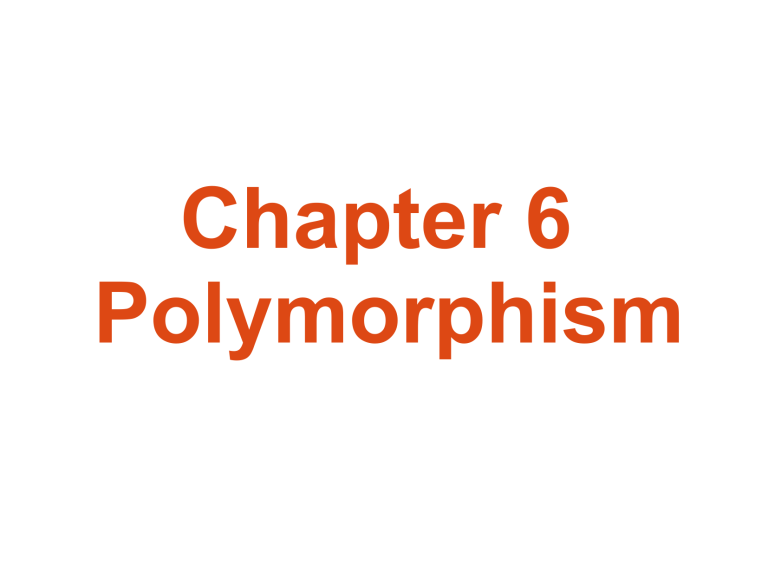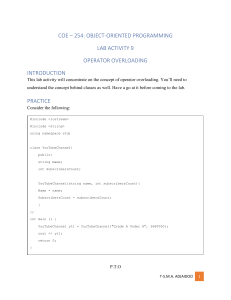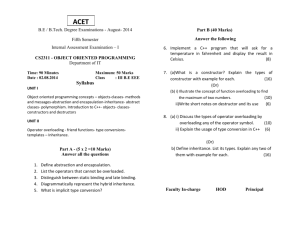
Chapter 6
Polymorphism
What is polymorphism
Polymorphism means ability to take more than
one form.
An operation may exhibit different behaviour in
different instances.
The behavior depends upon the types of data
used in the operation.
Eg. function overloading, function overriding,
virtual function,operator overloading
There are two type of polymorphism
1.Compile time polymorphism
2.Run time polymorphism
Compile time polymorphism
It means that an object is bounded to its
function call at compile time that is linking to
function call to function definition is done at
compile time.
Function which is being get called is known
before
This can be implemented without using pointer
This is known as earlier binding or static
binding.
Example:function overloading,operator
overloading
Run Time Polymorphism
It means that an object is bounded to its
function call at run time that is linking to function
call to function definition is done at run time.
Function which is being get called is unknown
until appropriate function selection is done.
This can be implemented using pointer
This is known as late binding or dynamic
binding.
Example: virtual function
Compile Time Polymorphism
Run Time Polymorphism
It means that an object is bounded to
its function call at compile time that
is linking to function call to function
definition is done at compile time.
It means that an object is bounded to
its function call at run time that is
linking to function call to function
definition is done at run time.
Function which is being get called is Function which is being get called is
known before
unknown until appropriate function
selection is done.
This does not require pointer to
object
This require to use pointer to object
Function calls are faster
Function calls execution is slower
This is known as earlier binding or This is known as late binding or
static binding.
dynamic binding.
Eg. Function overloading,operator
overloading
Eg. Virtual Function
Compile time polymorphism can be
implemented using
1.function overloading
2.Operator overloading
Function Overloading
This means that we can use the same function
name to create function that performs variety
of different tasks.
We can design multiple function with one
function name but different argument lists.
The function would perform different operation
depending on the argument list in the function
call.
The correct function to be invoked is
determined by checking the number and type
of the arguments but not on the function type.
Eg.
void add(int a,int b);
int add(int x,int y);
int add(int x,int y,int z);
void add(float p,float q);
Operator Overloading
This means that giving special meaning to an
operator is known as operator overloading.
operator overloading provides a flexible option
for the creation of new definitions for most of
the C++ operator.
We can overload all the c++ operator except the
following.
Class member access operator(.,.*)
Scope resolution operator(::)
Size operator(sizeof)
Conditional operator(?:)
The semantics of an operator can be
extended,we can't change its syntax.
When operator is overloaded its original
meaning is not lost.
Eg. operator + which is overloaded to add two
vectors can still be used to add two integers.
To
define
additional
task
to
an
operator(operator overloading) we must
specify what it means in relation to the class to
which the operator is applied.
This id done with the help of special function
called operator function.
The general form of operator function is:
return_type class_name::operator(op-arglist)
{
Function body;
}
Rules for Operator Overloading
Operator function must be either member
function(non-static) or friend function
A friend function will have only one
argument for unary operator and two for
binary operator.
A member function has no argument for
unary operator and only one for binary
operator.
The object used to invoke the member function
is passed implicitly.
Argument may be passed either by value or by
reference.
The process of overloading involves the
following steps:
1.Create a class that defines the data type that
is to be used in the overloading operation.
2.Declare the operator function operator op() in
the public part of the class(it may be either
friend function or normal member function).
3.Define the operator function to implement the
required operation.
Virtual Function
Polymorphism refers to the property by which
object belonging to different classes are able
to respond to the same meassge,but in
different form.
Essential requirement of polymorphism is
therfore the ability to refer object without any
regards to their classes.
This necessitates the use of a single pointer
variable to refer to the objects of different
classes
We use the pointer to base class to refer to all
derived class objects.But,we just observed that
a base pointer,even when it is made to contain
the address of a derived class,always execute
the function in the base class.
The compiler simply ignores the contents of
the pointer and choose the member function
that matches the type of the pointer.
To achieve polymorphism in this case we use
concept of virtual function.
When we use the same function name in both
base and derived clases,the function in base
class is declred as virtual using virtual
keyword.
When a function is made virtual,c++
determines which function to use at run time
base don the type of object pinted to by the
base pointer, rather than the type of the pointer
Rules for Virtual Function
1.The virtual function must be member of some
class.
2.They can't be static members.
3.They are accessed by using object pointer
4.A virtual function can be a frriend of another
class
5.A virtual function in a base class must be
defined,even though it may not be used
6.The prototype of the base class version of a
virtual function and all the derived class
versions must be identical.
7. We can't have virtual constructor,but we can have
virtual destructor.
8. While a base pointer can point to any type of the
derived object.the reverse is not true.That is, we
cannot use a pointer to aderived class to access an
object of abse type.
9.
When a base pointer points to a derived
class,incrementing or decrementing it will not make it
to point to the next objct of the derived class.It is
incremented or decremented only relative to its base
type.
10. If a virtual function is defined in the base class,it
need not be necessarily fedefined in the derived
class.In such case.class will invoke the base function.



